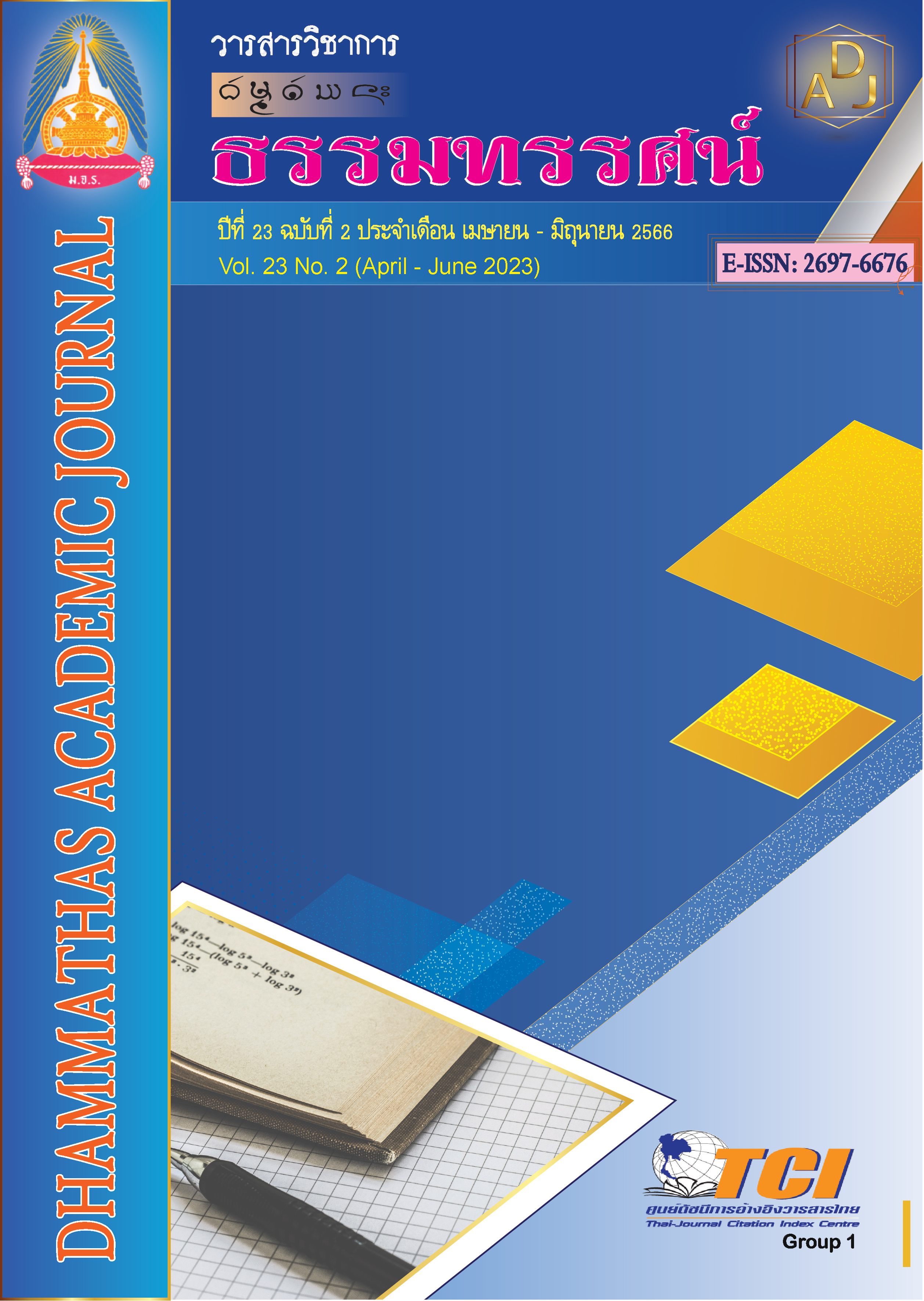Guidelines for Applying Buddhist Principles for the Development of the Students in La Salle Chotiravi Nakhonsawan School
Main Article Content
Abstract
This research has three objectives: 1) to study Buddhist principles for youth development, 2) to study the current state of the use of Buddhist principles for the development of students in La Salle Chotiravi Nakhonsawan School and 3) to propose guidelines for Applying Buddhist Principles for the Development of the Students in La Salle Chotiravi Nakhonsawan School. This research is the qualitative by collecting data from documents, focus group, and interviews with key informants by using content analysis techniques for context.
The research results were as follows:
1. Buddhist principles for youth development are the teachings of the Buddha that he discovered to be a complete human being, both physically and mentally. By Buddhist principles for youth development is for four cultivations 1) Physical development 2) Moral development 3) Cultivation of the heart and 4) Cultivation of wisdom as the main development framework aspects; social, behavioral, emotional, and cognitive. Other Buddhist principles will be a factor that drives each aspect to be appropriate in different contexts.
2. Current events, the using Buddhist principles for student development in La Salle Chotiravi Nakhonsawan School is the context of academy courses. Then it is the use of Buddhist principles for student development through student development activities, which is consistent with the 4 cultivations as mentioned above. And the development of students in all aspects must promote additional teachings and learning activities.
3. Guidelines for Applying Buddhist Principles for the Development of the Students in La Salle Chotiravi Nakhonsawan School. It is done through teaching and learning activities and student development activities. According to the framework of the four prayers, they are: 1) being able to live together in society, 2) having normal physical and verbal behavior, 3) having a stable mood, and 4) having the knowledge to be able to live in a stable, prosperous, and sustainable society.
Article Details

This work is licensed under a Creative Commons Attribution-NonCommercial-NoDerivatives 4.0 International License.
เพื่อให้เป็นไปตามกฎหมายลิขสิทธิ์ ผู้นิพนธ์ทุกท่านต้องลงลายมือชื่อในแบบฟอร์มใบมอบลิขสิทธิ์บทความ ให้แก่วารสารฯ พร้อมกับบทความต้นฉบับที่ได้แก้ไขครั้งสุดท้าย นอกจากนี้ ผู้นิพนธ์ทุกท่านต้องยืนยันว่าบทความ ต้นฉบับที่ส่งมาตีพิมพ์นั้น ได้ส่งมาตีพิมพ์เฉพาะในวารสาร วิชาการธรรม ทรรศน์ เพียงแห่งเดียวเท่านั้น หากมีการใช้ ภาพหรือตารางของผู้นิพนธ์อื่นที่ปรากฏในสิ่งตีพิมพ์อื่นมาแล้ว ผู้นิพนธ์ต้องขออนุญาตเจ้าของลิขสิทธิ์ก่อน พร้อมทั้ง แสดงหนังสือที่ได้รับการยินยอมต่อบรรณาธิการ ก่อนที่บทความจะได้รับการตีพิมพ์References
โรงเรียนลาซาลโชติรวีนครสวรรค์. (2561). หลักสูตรสถานศึกษาโรงเรียนลาซาลโชติรวีนครสวรรค์. นครสวรรค์: โรงเรียนลาซาลโชติรวีนครสวรรค์.
พระเมธีธรรมาภรณ์ (ประยูร ธมฺมจิตฺโต). (2539). พระพุทธศาสนาในยุคโลกาภิวัตน์ เล่มที่ 11. (พิมพ์ครั้งที่ 2). กรุงเทพฯ: มูลนิธิพุทธธรรม.
พระศักดิ์ดา วิสุทฺธิญาโณ (มรดา). (2551). การพัฒนาทรัพยากรมนุษย์ตามหลักพระพุทธศาสนา. (วิทยานิพนธ์พุทธศาสตรมหาบัณฑิต). พระนครศรีอยุธยา: มหาวิทยาลัยมหาจุฬาลงกรณราชวิทยาลัย.
มหาจุฬาลงกรณราชวิทยาลัย. (2539). พระไตรปิฎกภาษาไทย ฉบับมหาจุฬาลงกรณราชวิทยาลัย. กรุงเทพฯ: มหาวิทยาลัยมหาจุฬาลงกรณราชวิทยาลัย.
ศิริศักดิ์ นันตี. (2556). การบูรณาการหลักการทางพระพุทธศาสนาในการพัฒนาทรัพยากรมนุษย์. (วิทยานิพนธ์พุทธศาสตรดุษฎีบัณฑิต). พระนครศรีอยุธยา: มหาวิทยาลัยมหาจุฬาลงกรณราชวิทยาลัย.
สมพร เทพสิทธา. (2544). ประวัติพระสารีบุตร กระทู้ธรรม อภิธรรมมูลนิธิ. เข้าถึงได้จาก http://www.dharma-gateway.com/monk/great_monk/pra-sareebutr.htm
สุภาพร ธวัชราภรณ์. (2560). การประยุกต์หลักพุทธธรรมเพื่อสร้างรูปแบบการมีส่วนร่วมของโรงเรียนเครือข่ายที่ 25 ในการป้องกันและแก้ไขพฤติกรรมการติดเกมออนไลน์ของเยาวชน. (วิทยานิพนธ์พุทธศาสตรดุษฎีบัณฑิต). พระนครศรีอยุธยา: มหาวิทยาลัยมหาจุฬาลงกรณราชวิทยาลัย.
MGR Online. (2561). ครูไม่ใช่บุคคลที่เด็กจะเคารพอีกต่อไป. เข้าถึงได้จาก https://mgronline.com/onlinesection/detail/9610000076547

